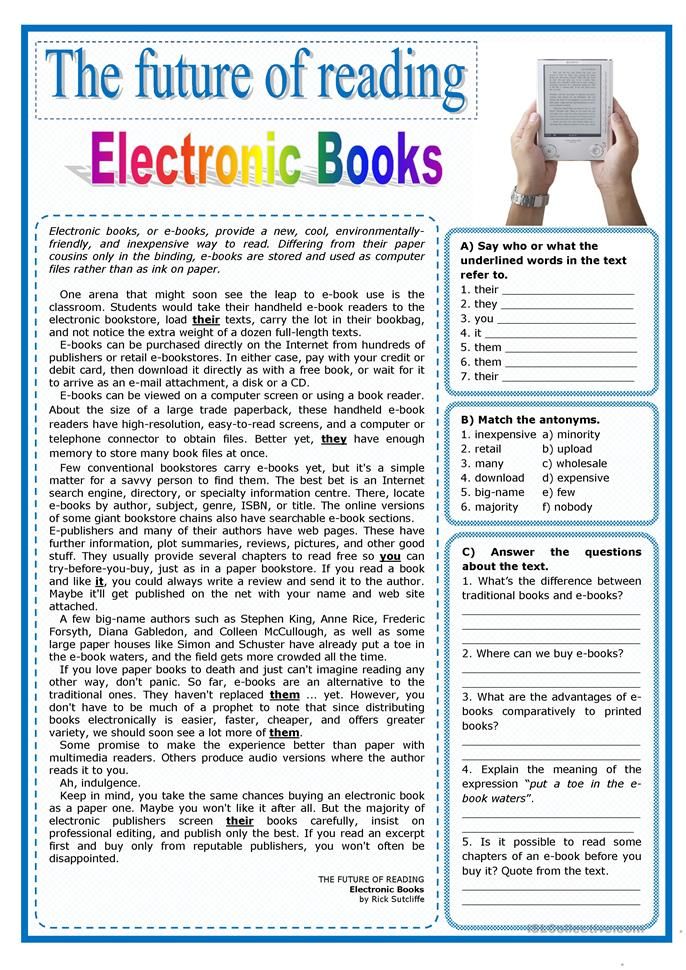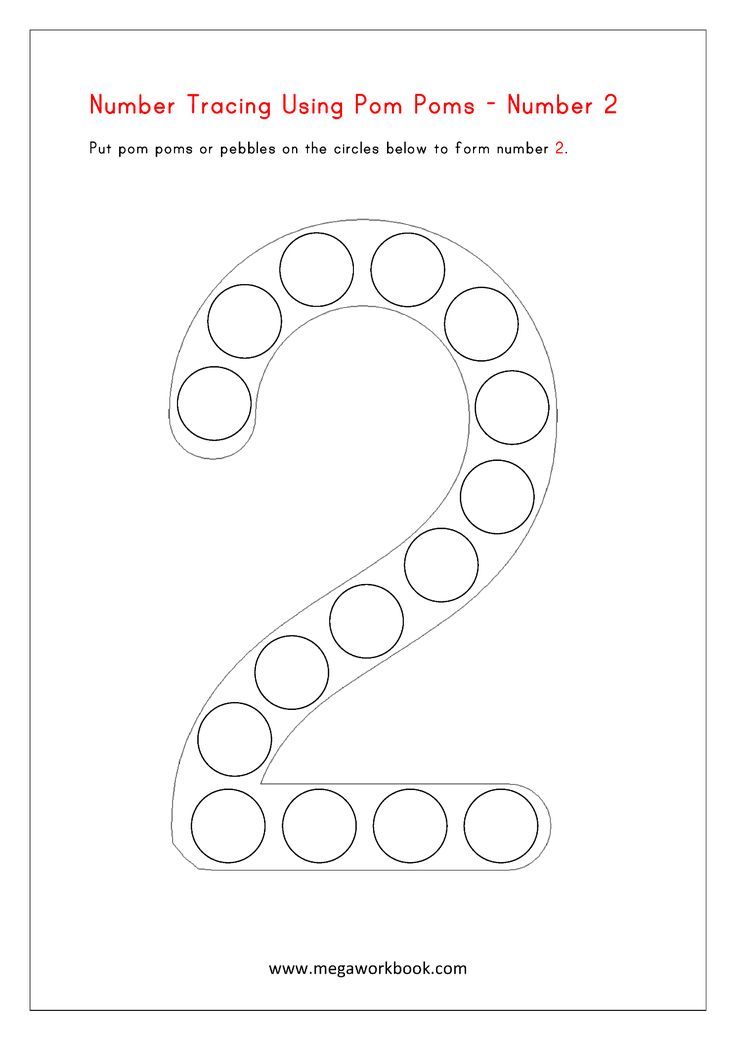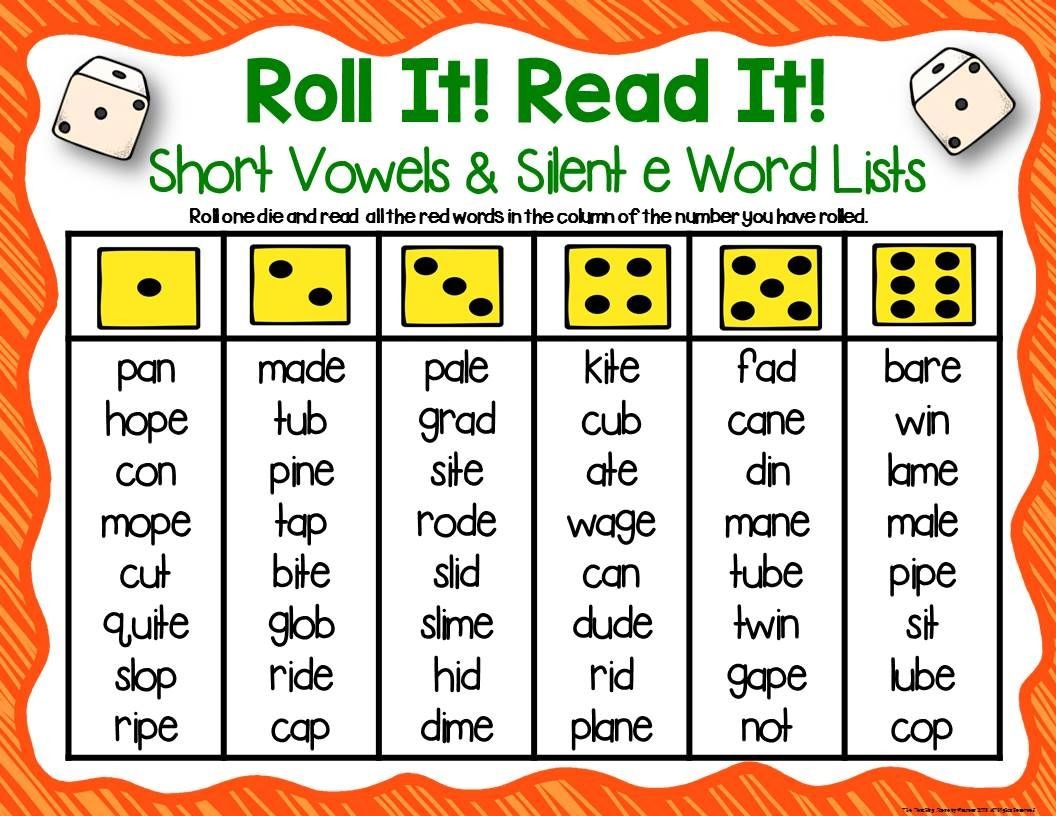How an excavator works
The Excavator Explained - Everything about Excavators
This article was last updated on October 31, 2022
Excavators are an essential piece of heavy equipment for most construction projects. Often referred to as diggers, excavators are used for all kinds of jobs like material handling, landscaping, demolition, mining projects, trenching, river dredging, and construction.
The Makeup Of An ExcavatorThe chassis of an excavator is made up of a boom, dipper, and bucket. These pieces connect to a cab that sits on a rotating house. Most excavator cabs can rotate a full 360 degrees for increased visibility. Excavators are available with either tracks or wheels depending on the manufacturer and the nature of the project.
Excavators are available in a variety of sizes and classes and can weigh up to 180,000 lbs. There are many other attachments for excavators that can take the place of the digging bucket to diversify the machine. By swapping out the bucket for an auger, drill, ripper, or rake, excavators can be used for many different jobs.
The best way to choose what excavator rental is needed for your project is to assess what exactly you need the machine to do. Identifying the right size of excavator, what attachments are needed, and how long you need the equipment will inform your decision to rent an excavator or buy one. It can be more efficient for a job to rent the right size of equipment for what is needed instead of trying to make one piece fit for a variety of jobs.
Excavators are often used for earthmoving projects or projects where lots of digging is required. That being said, the variety of attachments and excavator rental sizes available make these excavation machines useful in excavation projects of all sizes.
Typically, excavator sizes and classes are broken down into the following categories: mini, medium, large, demolition, long-reach, and wheeled. There are also specialty excavators made specifically for mining. Which size of digger you choose to buy or rent is often determined by the excavator's operating weight.
From a landscaping project to the construction of a completely new high-rise skyscraper, you can expect to see an excavator on almost any construction project, especially in the early stages. The variation in size allows them to be used in big construction projects and small backyard renovations. In addition to the different sizes of excavators, there are also several different types of excavators.
What Are The Different Types of Excavators?The Cable vs. Hydraulic Excavator
The difference between the cable and hydraulic excavator comes from how the parts of the machine move. Cable excavators use a series of steel wires and cables to move the main parts and replaced steam shovels in the early 1900s.
Hydraulic excavators work by allowing the operator to use levers to control the movement of the hydraulic system to push and move the cylinders that control the boom and bucket of an excavator.
Find the average excavator rental rates in your area
The 6 Kinds of Excavators
There are seven key types of excavators available on the market: Crawler Excavators, Dragline Excavators, Suction Excavators, Long-Reach Excavators, Mini Excavators, and Wheeled Excavators.
1. Crawler Excavators:
The most commonly recognized excavator used for mining, trench digging, and landscape grading is the crawler excavator. Crawler excavators get their name because of the way they travel on a job site with their tracks. They are incredibly powerful machines with hydraulic power. Because of the tracks, they are better suited for rough and uneven terrain.
2. Dragline Excavators:
Dragline excavators are a larger kind of excavator that uses a hoist rope and dragline system to clear dirt and soil for underwater projects, pile driving, or road excavations. Because of their weight and awkward shape, they're normally hauled in separate pieces to a job site before being assembled. These excavators are used for larger job sites and projects.
3. Suction Excavators:
Suction excavators use water jets and a high-pressure vacuum to clear dirt, soil, and debris. Operated out of a wheeled vehicle, the suction excavator is used for underground applications, debris cleanup, and other delicate excavation projects.
4. Long-Reach Excavators:
With arms that extend up to 100 feet with attachments, the excavator is good for heavy-duty digging, industrial demo projects, and reaching further than most other excavators.
5. Mini Excavator:
A compact, smaller version of a crawler excavator, mini excavators are useful in narrow job sites, job sites with obstacles, and jobs with delicate terrain like landscaping. Mini excavators have zero tail-wing capability and are ideal for small jobs. Mini excavators are also popular for home and DIY landscape projects.
When picking between renting an excavator vs a mini excavator, the size of the project and load size are usually the most important factors.
6. Wheeled Excavator:
The wheeled excavator is the same as a regular excavator but is fitted on wheels instead of tracks. Wheeled excavators are more popular in Europe and are typically used for working in urban areas since their wheels are kinder to finished roads and pavement than the traditional metal track. However, wheeled excavators are becoming more popular for their use in city projects.
However, wheeled excavators are becoming more popular for their use in city projects.
Read more about the differences between tracked and wheeled excavators.
Popular Attachments for ExcavatorsThere are many different mini excavator attachments out there. Renting a specialized attachment can make your machine function more efficiently and work smoother for specific jobs. While there are 10 more popular types of excavator attachments - both for mini excavators and standard machines - you can pretty much rent the attachment that works best for the job you're doing.
The traditional excavator is fitted with a bucket that digs toward the cab and machine. However, this type of digging arm can have a thumb attachment instead which makes it easier to lift and move materials. There are also several types of buckets that can be attached to an excavator.
A rock bucket and a V bucket are two bucket types that can be attached to an excavator. A rock bucket looks similar to a digging bucket but with longer sharper teeth and a narrow V-shaped edge for cutting. The reinforced structural parts of a rock bucket give it the ability to break through hard rock while still maintaining structural integrity. The V bucket simplifies the task of digging trenches and is useful for laying utility cables and pipes.
A rock bucket looks similar to a digging bucket but with longer sharper teeth and a narrow V-shaped edge for cutting. The reinforced structural parts of a rock bucket give it the ability to break through hard rock while still maintaining structural integrity. The V bucket simplifies the task of digging trenches and is useful for laying utility cables and pipes.
Excavators can also be fitted with an auger attachment for digging holes, hammers for breaking up hard concrete and rock, rippers, compactors, rakes, and many other different kinds of tools. All of these attachments help to make the excavator a true multipurpose equipment type.
Manufacturers of ExcavatorsThere are many different manufacturers to consider when looking to buy or rent an excavator. Most companies make different sizes and models of excavators to accommodate projects of all sizes and natures.
A variety of excavators are available for rent through DOZR. There are options to search for excavators ranging from 18 tons to 80 tons as well as high-reach excavators, long-reach excavators, and wheeled excavators for rent. The following is a look at some more popular brands of excavator manufacturers.
The following is a look at some more popular brands of excavator manufacturers.
Caterpillar – also called CAT – was founded in 1925 when C. L. Best Tractor Company joined with Holt Manufacturing Company – the same Holt family responsible for the continual-track system. Caterpillar is one of the most recognized brands of heavy equipment and machinery and is one of the largest heavy equipment manufacturing companies in the world. Caterpillar introduced a series of excavators – called the 200 series – in 1972.
Now, caterpillar excavators feature fuel-efficient engines and the latest safety tech and are designed with productivity in mind. CAT excavators are some of the best-performing earthmoving machines on the market, making them very popular equipment rentals. Their largest excavator is the 395 - Tier 4 model weighing in at 207,300 lbs, just over 100 tons, with a dig depth of 32 feet.
VolvoIt was 1832 in Eskilstuna, Sweden when 27-year-old Johan Theofron Munktell prepared the foundations for the company Volvo Construction Equipment. Today, Volvo excavators continue to push the boundaries of earthmoving and digging equipment. In 2019, Volvo CE announced the goal of launching a range of electric compact excavators and wheel loaders by mid-2020.
Today, Volvo excavators continue to push the boundaries of earthmoving and digging equipment. In 2019, Volvo CE announced the goal of launching a range of electric compact excavators and wheel loaders by mid-2020.
Volvo's line of excavators includes larger crawler excavators, medium crawler excavators, medium-wheeled excavators, and compact, or short-swing, excavators. Volvo is most well-known for its wheeled excavators. Volvo's largest excavator is the EC950F weighing in close to 210,000 lbs or 105 tons with a maximum dig depth of just under 30 feet.
KomatsuKomatsu was established in 1917 in Japan and established in North America later on in 1970. Their introduction to the American market for hydraulic excavators happened with their H-Series in the 1960s, a little before they truly established themselves in America.
Manufacturing all sizes of excavation machinery, Komatsu excavators are for all kinds of projects. With mid-size excavators, large excavators, and surface mining excavators, you're sure to find a Komatsu excavator that will be right for the job. The largest Komatsu excavator is the PC1250LC-11 with an operating weight of 270,000 lbs, a reach of up to 56 feet, and a dig depth of 38 feet.
The largest Komatsu excavator is the PC1250LC-11 with an operating weight of 270,000 lbs, a reach of up to 56 feet, and a dig depth of 38 feet.
John Deere established his company – named after himself – in 1837. In 1969 the first John Deere excavator, the JD690, was introduced. Now, they make over 20 different kinds of excavators ranging in size, weight, and horsepower.
John Deere's largest excavator, the 870 P-Tier, allows for almost 37 feet of dig depth and weighs over 188,000 lbs. John Deere also manufactures compact excavators, another name for mini-excavators, mid-size excavators, and other large excavators.
HitachiEstablished in the early 1900s in Japan, Hitachi didn't start manufacturing construction equipment until the 1950s. Since then, Hitachi has become an innovator in heavy machinery and their excavators are no exception. Currently, Hitachi has 37 excavators on the market.
Hitachi excavators include all sizes of excavators ranging from their smallest non-mini excavator model, the ZX160LC-6, to their biggest excavator, the ZX890LC-6.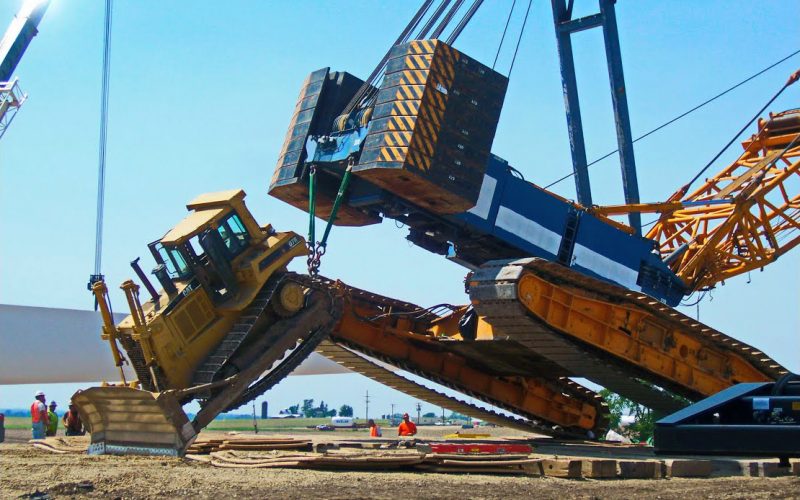 These models have operating weights and dig depths of 39,000 lbs and 21 feet, and 186,511 lbs and 31 feet, respectively. Hitachi also manufactures mining excavators and mini excavators.
These models have operating weights and dig depths of 39,000 lbs and 21 feet, and 186,511 lbs and 31 feet, respectively. Hitachi also manufactures mining excavators and mini excavators.
Hyundai
Founded in South Korea in 1985, Hyundai built their first excavators in 1988, a 21-ton excavator and a 29-ton excavator. Now, the portfolio of Hyundai excavators includes 16 current models and 28 previous models. The smallest Hyundai excavator model currently, outside of their compact excavators, is the HX130A LCR with an operating weight of just under 15 tons. Their largest excavator is the HX900L with an operating weight of 103 tons.
Doosan
Creating its construction division in 1977, Doosan has been producing excavators since 1978. However, it wasn't until 1994 that Doosan excavators came to America. Doosan currently manufactures crawler excavators, wheeled excavators, and mini excavators. Between the crawler excavators and wheeled excavators, they have 18 products.
The smallest crawler Doosan makes is the DX140LC-7 with an operating weight of 16 tonnes (32,187 lbs) and a dig depth of just over 19 feet. The biggest Doosan excavator is the DX800LC-7 with an operating weight of 90 tonnes and a dig depth of over 27 feet.
Potential Hazards & Safety Protocols for Excavators
Operating any kind of heavy equipment could pose a safety hazard. It is important to always be careful and to only operate heavy equipment and digging machinery like excavators after receiving proper training. Being consistent and following safety protocols can help keep all excavation operations safe. Here are some ways to stay safe while operating an excavator:
-
Never dig under structures like sidewalks without proper support systems
-
Wear a hardhat, safety vest, ear protection, and protection
-
Never dig underneath an excavator
-
Maintain the cab by cleaning up garbage and maintaining clear windows
-
Avoid making sharp turns or sudden movements while operating an excavator
-
Always lower the bucket when parked and park on a level surface
-
Do not travel diagonally on slopes but directly up
-
Map out an excavator route that is as flat as possible
-
Never exceed the maximum weight capacity of an equipment piece
-
Lower the bucket closer to the ground when driving for visibility purposes
-
Check all blind spots before moving equipment
-
Make sure to report any safety hazards and have any needed repairs performed immediately
-
Always wear a seatbelt
-
Check site plans and call local utility companies before beginning to dig
The most important point to remember for any operation of heavy equipment is to only do so if training has been provided and it is safe to do so.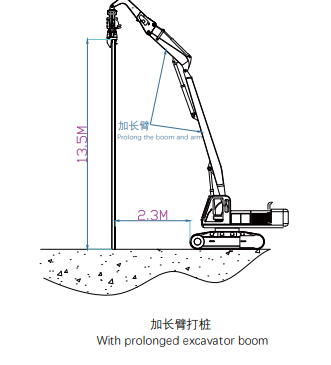 There are also some tips and tricks online for special projects like operating an excavator on a slope. Always request training before agreeing to operate a piece of new machinery.
There are also some tips and tricks online for special projects like operating an excavator on a slope. Always request training before agreeing to operate a piece of new machinery.
The first machine to resemble an excavator was the steam shovel. An ancient dinosaur next to the modern excavator, this piece of equipment was a game-changer when it was invented by William Otis who in 1839 received a patent for the design. It was originally fitted on railway tracks to allow mobility.
The machine could move up to 300 cubic yards a day compared to the 12 cubic yards that could be moved by a man. This machine was used to build the Panama Canal and dig the foundations of early skyscrapers. The machine was used and updated into the 1920s as tracked and wheeled equipment became more popular. In 1931 the last railroad shovel was shipped.
Much like with the bulldozer and other pieces of equipment, various pieces had to come together to create the excavator. Sir W.G. Armstrong & Co. was a British business that had developed the hydraulic system that would be used in the modern excavator.
Sir W.G. Armstrong & Co. was a British business that had developed the hydraulic system that would be used in the modern excavator.
Designed to use water instead of hydraulic fluid, this system was invented in 1882. The first hydraulic shovel was patented by Kilgore Machine Co in Minnesota in 1897 and used the technology developed by Sir W.G. Armstrong & Co.
None of these excavators could rotate the full 360 degrees that exist now with the modern excavator. This didn’t happen until the 1960s when a French company called Poclain invented an excavator with cylinders and a hydraulic pump. The TY45 made history as the first fully revolving hydraulic excavator.
The Excavator: FAQCan excavators be used for land clearing?
Excavators are one of the best land-clearing equipment rental options. They're great for clearing trees and moving heavy loads and their tracks make them great for uneven terrain. If you're looking to rent land-clearing equipment, excavators are a great choice.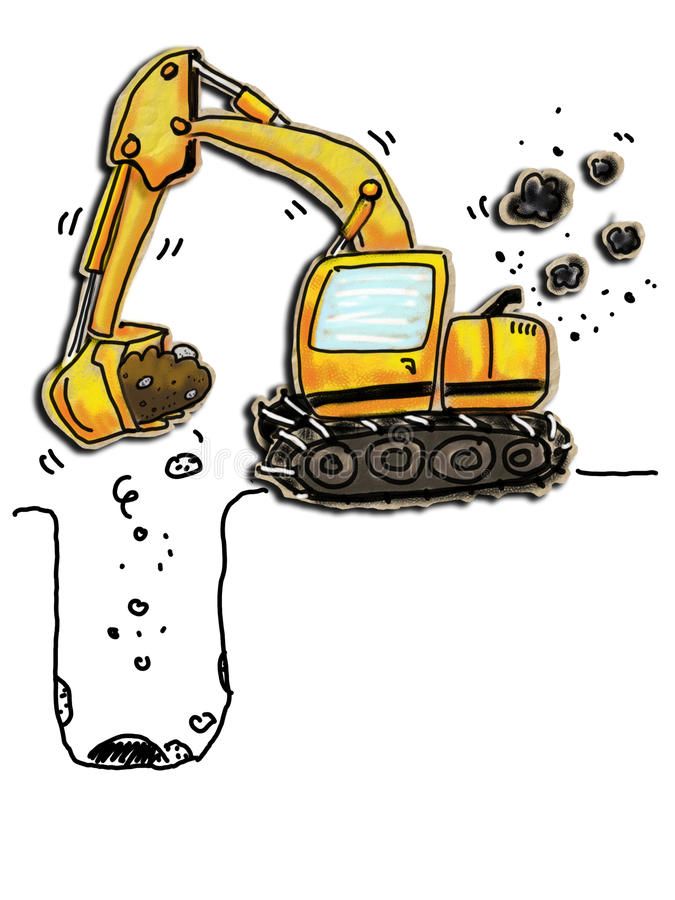
What is the difference between an excavator vs a backhoe?
Excavators are larger machines that are used primarily for heavy-duty jobs like trenching, demolition, mining, and land clearing because they have longer arms and can dig deeper than a backhoe. Excavators also provide more digging functionality because they can turn on their cab a full 360 degrees.
Backhoes are smaller excavating machines that offer more versatility but are typically seen on smaller construction projects like residential, snow removal, or loading jobs because of their limited dig depth potential. Whether you pick between a backhoe vs an excavator is dependent on the size of the job.
How deep can an excavator dig?
The depth capacity of an excavator will depend on the size of the equipment. Some specific kinds of excavators – like a long-reach model – make it easier to dig deeper than possible with a regular excavator. Typically, the heavier the operating weight of the excavator the deeper it can dig but it's always worth reviewing the specifications of the equipment before use.
What is the proper digging position for an excavator?
The proper position for digging with an excavator will differ depending on the terrain, the size of the equipment, the location of the dig site, and the nature of the job.
The best way to set up a dig for success is to take the time to plan before starting. Organizing where the scoop pile will go and where to stage other needed materials will keep the dig safe once it is started. Reading site plans to identify underground hazards like wires or pipes will ensure the productivity and efficiency of a job. Take time to paint lines before digging to align the first dig.
All of these steps help to create a safe working environment which is the first step to proper digging with an excavator.
Can I rent an excavator?
Yes, excavators can be rented for use. You can search DOZR Marketplace for excavators of all sizes to find an excavator rental near you. Rentals are available by the day, week, or month depending on your project length and needs.
The cost to rent an excavator changes depending on the length of the rental and who the supplier is. You can view all prices and compare them in the DOZR search results.
How does an excavator work?
An excavator is a large construction machine made for digging into the ground with its bucket to extract earth or other material to create trenches, holes and foundations. It usually runs off diesel fuel and, depending on the size of the equipment, can be used on a medium to large job-sites.
A standard hydraulic excavator structure consists of:
- Hydraulic Arm (comprising a boom, arm, bucket, and the required cylinders)
- The House which is a swing platform (containing cab, counterweight, engine and pumps for hydraulics) and has the ability to rotate 360 degrees on its own axis.
- Undercarriage with tracks or, occasionally, wheels.
Common uses of a hydraulic excavator
The hydraulic excavator’s main functions are to excavate, rotate, move, load, mobilise and demobilise objects.
Some examples of these activities are:
- Trenching in construction work for pipes, drains and cables to be installed.
- Digging ditches, foundations, and ramps in construction, agriculture and mining.
- Excavation of materials and structures in building work.
- Demolition, using a hydraulic hammer or even a wrecking ball as attachments.
- Load handling – loading or unloading large or heavy materials.
The load capacity of hydraulic excavators depends on the size of the equipment, which ranges from mini-excavators which can manage under 7 tons, to large units which work with loads of 45 to 80 tons.
Where does a hydraulic excavator’s power come from?
Excavators are powered by diesel due to the extreme efficiency from maximum horsepower being obtained from the engines. The tracks and the hydraulic pumps used to raise and extend the excavator’s arm are powered by the diesel engine. The forward and reverse movements of the unit, as well as that of the arm, are all controlled from the operator’s cabin via various pedals and levers.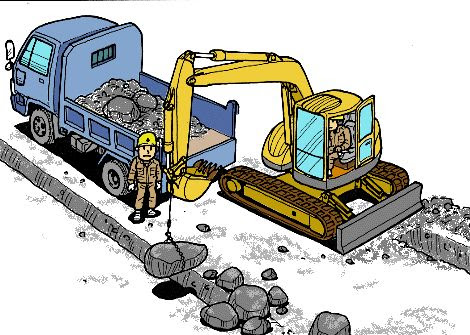
Track Steering in Excavators
Tracks are made of multiple components which become ridged once fitted to the excavator. The tracks (made up of track shoes bolted together into a circular track) surround the gears which receive their power from the engine via the driveshaft. The tracks move the digger in a straight line, backwards and forwards when the gears are engaged.
The excavator is turned by the operator stopping one track in place and moving the other track which spins the entire unit around. A very experienced operator can even turn the unit in a tighter space by engaging ‘reverse’ on one track and ‘forward’ on the other, which is a great accomplishment.
How does the excavator arm move?
The arm movement on excavators is 100% hydraulically controlled. The excavator’s arm forms part of the lower frame chassis. The arm consists of two sections – the boom (the section from the excavator to the arm) and the arm (from the boom to the bucket) which are joined by a hinge.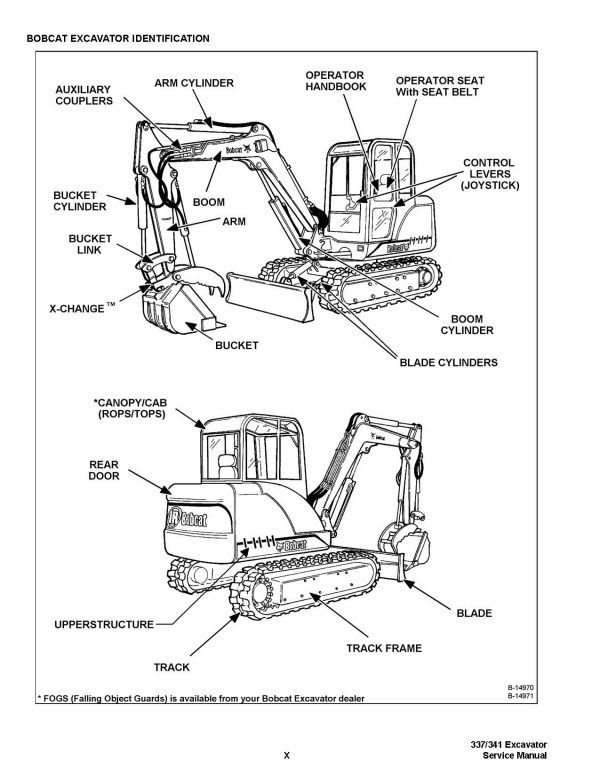 Both arm and bucket are controlled by three separate hydraulic cylinders, which operate together to allow the arm to extend and retract.
Both arm and bucket are controlled by three separate hydraulic cylinders, which operate together to allow the arm to extend and retract.
- Piston one is attached beneath the boom and when it is extended, the arm lifts up.
- The second piston is attached to the top of the arm and this gives more reach by raising and lowering the arm.
- The third piston controls the motion of the bucket to enable it to scoop and dig.
Komatsu Excavators for all sizes of job sites
MMI is the official Komatsu dealer for Zimbabwe offering over 20 different excavators and shovels in this region, as well as being a global leader in the supply of Japanese-engineered mining, construction, earthmoving and utility equipment in Southern Africa. The MoJo Motor Industries (MMI) Team comes with over fifty-four years of combined experience in automotive, construction and mining equipment sales and support. MMI is the official Komatsu dealer for Zimbabwe. Please direct all your pre-sales or equipment enquiries on excavators to our friendly staff.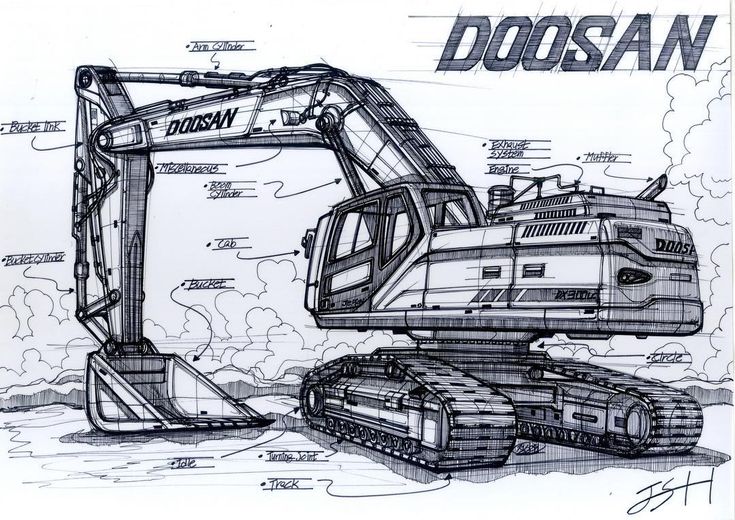
How an excavator works
Single-bucket excavators are machines with cyclical action, since due to the presence of only one bucket, continuous work becomes impossible, and therefore excavation and transfer of soil is carried out cyclically. This somewhat reduces labor productivity compared to multi-bucket counterparts. However, in view of the versatility of use and the possibility of installing special nozzles that expand the capabilities of this special equipment, it is in steady demand when performing various types of work with the soil. Most often, excavators are used in conjunction with other special equipment. For example, during the construction of roads, they interact with bulldozers that produce a dump of waste soil.
How does a single bucket excavator work?
Any single-bucket model sequentially performs:
- scooping soil with a bucket;
- moving it to the right place where it will be unloaded;
- overturning of the bucket, accompanied by spillage of soil.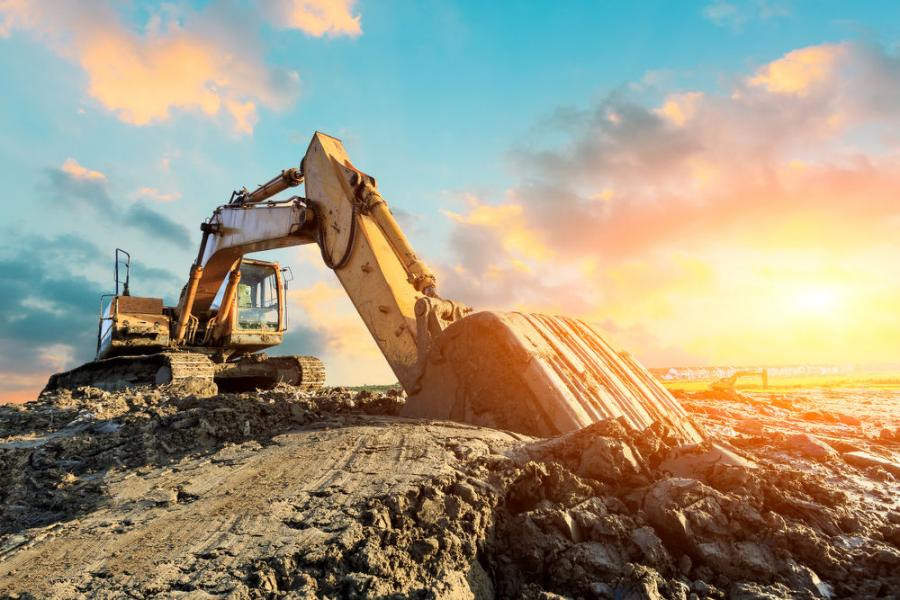
This equipment consists of three main units:
- running gear;
- turntable;
- specialized equipment that allows you to perform a certain type of work.
The undercarriage ensures the movement of the load. It receives and transmits the load from the machine. Modern special equipment has three types of undercarriage:
- caterpillar. The traditional option, which, however, is not suitable for use in the city. Such cars cannot navigate the tracks on their own;
- pneumatic wheel;
- wheeled, ideal for the city. So the wheeled Hyundai R 170W-7 model can move on roads for various purposes on a par with conventional cars.
Rotation of the platform is provided by a turntable. Typically, the rotation is 360 degrees. However, there are also part-turn machines that are not able to make a full turn.
In addition to the standard equipment, modern models can be equipped with additional equipment, which allows to significantly expand the possible area of their use.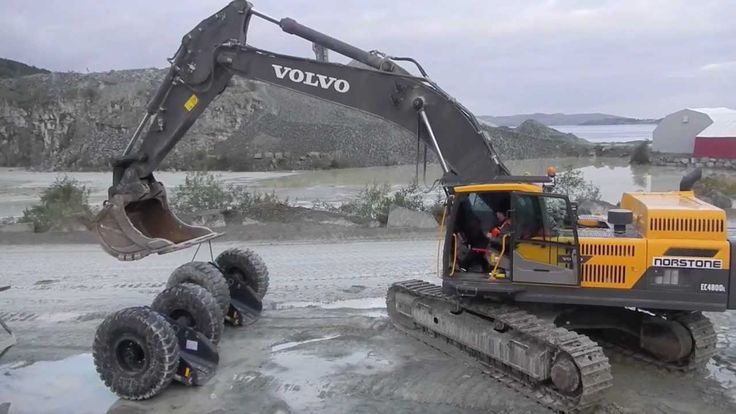 This can be, for example, a hook or a hydraulic hammer head.
This can be, for example, a hook or a hydraulic hammer head.
Depending on the type of suspension, the division is made into models with:
- flexible. In this design, the arrow is fixed on the ropes;
- rigid. Work is carried out through the use of a swivel joint. The equipment is driven by hydraulic cylinders;
- telescopic boom.
In addition to cyclic machines, continuous excavators are produced. Due to their design, they are able to work continuously. Such special equipment throws the soil to the side, creating a dump. This type of excavator can be rotary and chain. Most often, this technique is used in the construction of roads or when cleaning and removing snow from the streets after a snowfall.
In the latter case, the buckets are located on a single-row or double-row chain. Rotary buckets have a rigid rotor rotated by special rollers. At the moment of rotation of the rotor, the soil or snow is taken by a bucket with teeth, and it is unloaded onto a special conveyor belt for moving to the dumping site.
With a sufficiently high productivity of special equipment of cyclic action, it cannot be called universal. Therefore, our company offers a large selection of single-bucket excavator models for rent, suitable for work in various conditions.
How JCB Backhoe Loader Forward and Reverse Works
The JCB Backhoe Loader is capable of forward and reverse travel. To move in one direction or another, as well as change the direction of movement when necessary, it is necessary to perform a clear sequence of actions. To move forward, gently push the left and right control levers forward, to move in reverse, pull the levers back.
Keep your equipment's controls perfectly clean. Due to dirt, grease, the operator's hand or foot may accidentally slip off during operation. This may result in loss of control of the machine.
Starting the engine
Before starting the engine, inspect the machine, remove dirt from the pedals and control levers. Remove all unnecessary items from the cab and carefully secure any items left inside. Check the operation of switches, windshield washers, lights.
Remove all unnecessary items from the cab and carefully secure any items left inside. Check the operation of switches, windshield washers, lights.
Turn the throttle control dial to the low position. Insert the starter key into the ignition socket, turn it to the ON position.
Before driving, make sure that there are no sources of potential danger, people, animals, vehicles, other machinery or equipment nearby. Inform others about the beginning of the movement by giving an audible signal.
Forward
To drive forward, start the backhoe loader engine and follow the instructions:.
Drive forward
- increase the engine speed by turning the throttle;
- fold the attachment as shown, make sure it is 40-50 cm from the ground;
- If you are using an extended reach backhoe loader, install the arm support stand and position the equipment as shown in the illustration instead.
- check direction of travel;
- Press the left and right control levers forward.
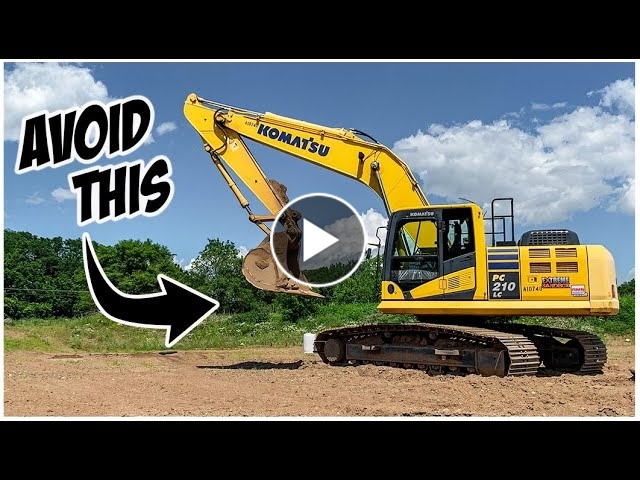
Backhoe Steering
- To turn right, push the left control lever forward only.
- To turn left, push the right control lever forward only.
If the left and right levers are turned simultaneously, the machine will turn in the same place.
Drive speed selection
The gears are switched using a lever on the control panel. When you press the lever, the speed changes to a higher one. If a maximum speed is set, pressing resets it to a lower speed. When the machine is stopped, the last settings are stored in memory, and the next time the backhoe loader is started, it immediately starts moving at the same speed at which it was moving before stopping.
The backhoe loader will move at high speed if the levers are operated quickly. The throttle control must first be set to high speed. Movement at high speed is carried out only on a horizontal surface. When climbing a slope, the speed is automatically reduced to medium. The descent from the slope must be carried out exclusively at low speed.
The descent from the slope must be carried out exclusively at low speed.
It is not recommended to change speed while driving. First stop the machine, then set the desired mode and start driving again.
Reverse
To reverse the backhoe loader, pull both control levers towards you while holding them parallel.
Reverse steering
The left handle controls the movement of the handle and the top structure. To turn the upper structure within its radius of action, it is necessary to deflect the handle to one side and hold it in this position. As long as the operator holds the handle, the top structure will rotate. When the handle is released, it immediately stops, as the parking brake is activated.
To turn the movement of the backhoe loader, you need to move the handle to the appropriate side, as shown in the figure:
- to turn left, the handle turns to the left;
- To turn right, turn the handle to the right.



